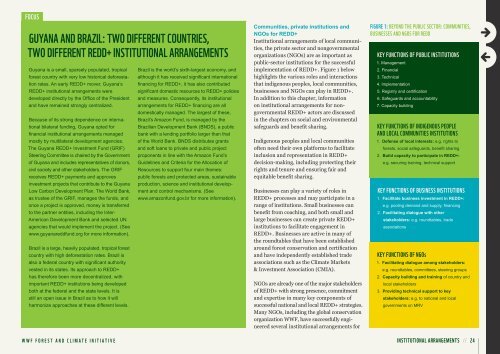WWF Guide to Building REDD+ Strategies
WWF Guide to Building REDD+ Strategies
WWF Guide to Building REDD+ Strategies
Create successful ePaper yourself
Turn your PDF publications into a flip-book with our unique Google optimized e-Paper software.
FoCuS<br />
Guyana and BRazil: tWo diFFeRent CountRieS,<br />
tWo diFFeRent Redd+ inStitutional aRRanGementS<br />
Guyana is a small, sparsely populated, tropical<br />
forest country with very low his<strong>to</strong>rical deforestation<br />
rates. An early <strong>REDD+</strong> mover, Guyana’s<br />
<strong>REDD+</strong> institutional arrangements were<br />
developed directly by the Office of the President<br />
and have remained strongly centralized.<br />
Because of its strong dependence on international<br />
bilateral funding, Guyana opted for<br />
financial institutional arrangements managed<br />
mostly by multilateral development agencies.<br />
The Guyana <strong>REDD+</strong> Investment Fund (GRIF)<br />
Steering Committee is chaired by the Government<br />
of Guyana and includes representatives of donors,<br />
civil society and other stakeholders. The GRIF<br />
receives <strong>REDD+</strong> payments and approves<br />
investment projects that contribute <strong>to</strong> the Guyana<br />
Low Carbon Development Plan. The World Bank,<br />
as trustee of the GRIF, manages the funds, and<br />
once a project is approved, money is transferred<br />
<strong>to</strong> the partner entities, including the Inter-<br />
American Development Bank and selected UN<br />
agencies that would implement the project. (See<br />
www.guyanareddfund.org for more information).<br />
Brazil is a large, heavily populated, tropical forest<br />
country with high deforestation rates. Brazil is<br />
also a federal country with significant authority<br />
vested in its states. Its approach <strong>to</strong> <strong>REDD+</strong><br />
has therefore been more decentralized, with<br />
important <strong>REDD+</strong> institutions being developed<br />
both at the federal and the state levels. It is<br />
still an open issue in Brazil as <strong>to</strong> how it will<br />
harmonize approaches at these different levels.<br />
Brazil is the world’s sixth-largest economy, and<br />
although it has received significant international<br />
financing for <strong>REDD+</strong>, it has also contributed<br />
significant domestic resources <strong>to</strong> <strong>REDD+</strong> policies<br />
and measures. Consequently, its institutional<br />
arrangements for <strong>REDD+</strong> financing are all<br />
domestically managed. The largest of these,<br />
Brazil’s Amazon Fund, is managed by the<br />
Brazilian Development Bank (BNDS), a public<br />
bank with a lending portfolio larger than that<br />
of the World Bank. BNDS distributes grants<br />
and soft loans <strong>to</strong> private and public project<br />
proponents in line with the Amazon Fund’s<br />
<strong>Guide</strong>lines and Criteria for the Allocation of<br />
Resources <strong>to</strong> support four main themes:<br />
public forests and protected areas, sustainable<br />
production, science and institutional development<br />
and control mechanisms. (See<br />
www.amazonfund.gov.br for more information).<br />
Communities, private institutions and<br />
NGOs for <strong>REDD+</strong><br />
Institutional arrangements of local communities,<br />
the private sec<strong>to</strong>r and nongovernmental<br />
organizations (NGOs) are as important as<br />
public-sec<strong>to</strong>r institutions for the successful<br />
implementation of <strong>REDD+</strong>. Figure 1 below<br />
highlights the various roles and interactions<br />
that indigenous peoples, local communities,<br />
businesses and NGOs can play in <strong>REDD+</strong>.<br />
In addition <strong>to</strong> this chapter, information<br />
on institutional arrangements for non-<br />
governmental <strong>REDD+</strong> ac<strong>to</strong>rs are discussed<br />
in the chapters on social and environmental<br />
safeguards and benefit sharing.<br />
Indigenous peoples and local communities<br />
often need their own platforms <strong>to</strong> facilitate<br />
inclusion and representation in <strong>REDD+</strong><br />
decision-making, including protecting their<br />
rights and tenure and ensuring fair and<br />
equitable benefit sharing.<br />
Businesses can play a variety of roles in<br />
<strong>REDD+</strong> processes and may participate in a<br />
range of institutions. Small businesses can<br />
benefit from coaching, and both small and<br />
large businesses can create private <strong>REDD+</strong><br />
institutions <strong>to</strong> facilitate engagement in<br />
<strong>REDD+</strong>. Businesses are active in many of<br />
the roundtables that have been established<br />
around forest conservation and certification<br />
and have independently established trade<br />
associations such as the Climate Markets<br />
& Investment Association (CMIA).<br />
NGOs are already one of the major stakeholders<br />
of <strong>REDD+</strong> with strong presence, commitment<br />
and expertise in many key components of<br />
successful national and local <strong>REDD+</strong> strategies.<br />
Many NGOs, including the global conservation<br />
organization <strong>WWF</strong>, have successfully engineered<br />
several institutional arrangements for<br />
FiGuRe 1: Beyond tHe PuBliC SeC<strong>to</strong>R: CommunitieS,<br />
BuSineSSeS and nGoS FoR Redd<br />
key FunCtionS oF PuBliC inStitutionS<br />
1. Management<br />
2. Financial<br />
3. Technical<br />
4. Implementation<br />
5. Registry and certification<br />
6. Safeguards and accountability<br />
7. Capacity building<br />
key FunCtionS oF indiGenouS PeoPle<br />
and loCal CommunitieS inStitutionS<br />
1. Defense of local interests: e.g. rights <strong>to</strong><br />
forests, social safeguards, benefit sharing<br />
2. Build capacity <strong>to</strong> participate in <strong>REDD+</strong>:<br />
e.g. securing training, technical support<br />
key FunCtionS oF BuSineSS inStitutionS<br />
1. Facilitate business investment in <strong>REDD+</strong>:<br />
e.g. pooling demand and supply, financing<br />
2. Facilitating dialogue with other<br />
stakeholders: e.g. roundtables, trade<br />
associations<br />
key FunCtionS oF nGos<br />
1. Facilitating dialogue among stakeholders:<br />
e.g. roundtables, committees, steering groups<br />
2. Capacity building and training of country and<br />
local stakeholders<br />
3. Providing technical support <strong>to</strong> key<br />
stakeholders: e.g. <strong>to</strong> national and local<br />
governments on MRV<br />
<strong>WWF</strong> FOREST AND CLIMATE INITIATIVE inStitutional aRRanGementS // 24

















